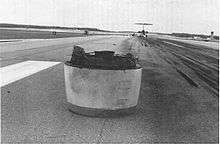Delta Air Lines Flight 1288
 N927DA in 2008 | |
| Accident | |
|---|---|
| Date | July 6, 1996 |
| Summary | Uncontained turbine failure |
| Site |
Escambia County, Florida, near Pensacola 30°28′40″N 87°11′25″W / 30.47778°N 87.19028°WCoordinates: 30°28′40″N 87°11′25″W / 30.47778°N 87.19028°W |
| Aircraft | |
| Aircraft type | McDonnell Douglas MD-88 |
| Operator | Delta Air Lines |
| Registration | N927DA[1] |
| Flight origin | Pensacola Regional Airport, Pensacola, Florida |
| Destination | William B. Hartsfield International Airport, Atlanta, Georgia |
| Passengers | 137 |
| Crew | 5 |
| Fatalities | 2 |
| Injuries | 5 |
| Survivors | 140 |
Delta Air Lines Flight 1288 was a regularly scheduled flight from Pensacola, Florida to Atlanta, Georgia. On July 6, 1996, the aircraft serving the flight, a McDonnell Douglas MD-88 equipped with Pratt & Whitney JT8D-219 turbofan engines, was on takeoff roll from Runway 17 at Pensacola when it experienced an uncontained, catastrophic turbine engine failure that caused debris from the front compressor hub of the number one left engine to penetrate the left aft fuselage. The impact left two passengers dead and two severely injured; the two dead were a mother and son. The pilot aborted takeoff and the airplane stopped on the runway. Three other passengers sustained minor injuries during the emergency evacuation. Most of the passengers were traveling on vacation.[2]
Pre-flight inspection
During the pre-flight inspection, the first officer noted a few drops of oil coming from the "bullet" or tip of the number one (left) engine, although it was said to be "not that serious". The first officer also noticed a couple of missing rivets on the left wing. The pilot told NTSB investigators that both problems were observed as non-threatening and that the aircraft was airworthy; therefore, maintenance was not informed.[3]
Takeoff and incident
At 2:23 pm CDT, Delta Flight 1288 was cleared for takeoff on Runway 17. As the first officer was advancing the throttles and reaching an airspeed of 40 knots, the cockpit lost lighting and instrumentation. The rear cabin passengers and flight crew heard a very loud bang and experienced a blast-like sensation. The pilot then ended takeoff by bringing the throttle to idle and engaging the brake, which brought the aircraft to an eventual stop without use of reversers or spoilers.[3]


Once the aircraft stopped, the first officer attempted to contact the tower; however, he was unable due to the cockpit's lack of power. The flight crew then activated emergency power, contacted Pensacola tower, and declared an emergency. The cockpit's jump-seat passenger, an off-duty Delta Boeing 767 pilot, went to inspect the rear of the aircraft. When the first officer saw the over-wing exits open and about half of the passengers missing along with hearing engine noise, he returned to the cockpit and advised the captain to kill the engines. At 2:27 pm CDT the pilot requested emergency medical assistance due to the jump-seat passenger's report of a large hole in the fuselage, engine debris throughout the cabin, and injured passengers. He then reported there was no evidence of smoke or fire in the cabin, and that the rear cabin door had been opened and the emergency slide was inflated. The flight attendant who initiated the evacuation through that door told the NTSB that she saw fire on the left engine and therefore abandoned evacuation through that door and directed passengers forward. She reported that there were many injuries and possibly two dead, and that therefore she began to evacuate the plane until she was stopped by the first officer. Due to the damage to and danger at the rear of the aircraft, the air stairs built into the MD-88 were found unsuitable to use. The captain then requested portable air stairs to deplane passengers, which arrived 25 minutes later.[3]
Injuries and deaths
Anita L. Saxton, 39, of Scottville, Michigan, and her 12-year-old son Nolan Saxton sustained fatal injuries.[4] Ms. Saxton's two other children, 15-year-old son Derek and 9-year-old daughter Spencer, sustained non-fatal injuries. Five total passengers were injured. One passenger was listed in serious condition with a fractured leg.[5]
NTSB investigation
After a total investigation, the NTSB determined the most probable cause of the accident was a fracture in the left engine's front compressor fan hub, which resulted from failure of the airline's fluorescent penetrant inspection process to detect a potentially dangerous crack in the fan which originated from the engine's initial manufacture. The NTSB also attributed the accident to the failure of Delta's maintenance team to discover the problem.
Aftermath
As of April 2018, the FAA reports the aircraft involved in the incident was repaired and returned to service with Delta under the same registration N927DA.[6][7] The Aircraft was withdrawn from use by Delta on August 10th, 2018.
See also
- Southwest Airlines Flight 1380 – A similar accident that happened in 2018, with one fatality
- Southwest Airlines Flight 3472 – A similar accident that happened in 2016, without fatalities
References
- ↑ "FAA Registry (N927DA)". Federal Aviation Administration.
- ↑ "2 die when engine shatters as jet takes off" (). Houston Chronicle. Sunday July 7, 1996. A1. Retrieved on February 13, 2009.
- 1 2 3 NTSB Report of Delta 1288, NTSB, January 13, 1998.
- ↑ MATTHEW L. WALDPublished: July 7, 1996 (1996-07-07). "2 Killed in Jet On Runway After Engine Breaks Apart - New York Times". Nytimes.com. Retrieved 2014-01-13.
- ↑ "2 Killed as Engine Parts Pierce Cabin of Delta Jet". Los Angeles Times. 1985-06-27. Retrieved 2014-01-13.
- ↑ "FAA Registry (N927DA)". Federal Aviation Administration.
- ↑ FAA aircraft registry http://registry.faa.gov/aircraftinquiry/NNum_Results.aspx?NNumbertxt=N927DA